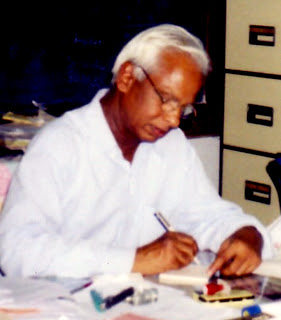Some who have read Introducing Saaralaa Mahaabhaarata, have written or spoken to me
about a few things concerning the book. I am rephrasing and organizing some of
them and am responding to the same here:
One: One misses a concluding
essay or section or at least some concluding remarks. On that account one feels
a sense of incompleteness about the book.
Response: The book begins with the
dedication, although this word is not used there, and ends with the
acknowledgement. From my point of view, the narrative starts with the dedication and ends with the
acknowledgement (setting aside the Director’s Foreword). The
bibliography is also a kind of acknowledgement, not unlike a statement of gratitude in spirit. I
think if one looks at the book this way, one would perhaps not have this feeling
of incompleteness about the book.
In all humility I have tried to capture
in my humble effort the traditional style of telling or composing a puranic text: seeking the
blessings of gods before telling the story, then telling the story and finally
expressing one’s gratitude to the gods because of whose grace alone the
composition could be completed. The dedication in the present book is really a
sort of invocation, seeking blessings, and my acknowledgement, expressing
gratitude to those whose help and good will I had received while working on
this book. As for the core narrative itself, I have not tried to tell Sarala’s story
from the beginning to the end. Therefore in a manner of speaking, there is no real
beginning, no real ending!
Two: About the structure of the book:
Response: A purana is recited or a
puranic story is told in several sittings. Not everyone finds it possible to
attend every sitting. The storyteller responds to this situation by making the contents
of the sittings a bit independent of one another. If one misses a sitting or
two one does not find oneself excluded from the telling. One major strategy the
storyteller uses for this purpose is repetition. He repeats certain key
episodes, so that the one who has missed a sitting can still get connected with the
main story. However, each time he repeats an episode, he interprets it slightly
differently, adding a little to its telling, so that those who have not missed
a sitting do not feel bored with the repetitions.
I have tried to follow this
pattern in this book. Each essay, which is the word used for a chapter, is, to
an extent, independent of the others; that is, it is not the case that if one
hasn’t read the first essay, one cannot follow the second, or if one hasn’t
read the first two essays, one cannot follow the third. One could even start
reading the book with the last essay. I have used repetition as a strategy to
bring unity to the presentation of the great poet’s celebrated work, and also to
enable the reader who is not reading the book from the first essay to the last
in a serial order to feel comfortable with the narrative. Incidentally, I wish I had used the word
“sitting” and not “essay”. That would have captured what I had in mind a great deal
better. In addition, at times I have tried to give the impression that there is
a certain looseness in my presentation – with a bit of overstaying with a thought or a
theme here and there, introducing an idea at one place but exploring its
meaning or significance in some detail elsewhere, etc. In doing this I have
tried to capture the traditional village storyteller’s rather meandering style of
storytelling.
Three: About whether it is a
translation of some episodes from Saaralaa
Mahaabhaarata and whether it is intended to be viewed as a piece of
literary criticism.
Response: A friend of mine who teaches
English literature at an institution of higher education in India wrote me
saying that the book reads neither like a conventional translation nor a piece
of conventional literary criticism. He felt that in some sense it is a fusion
of both. I was happy he saw it that way; he understood very well what I have
tried to do.
I have attempted here to give the
readers a flavour of Sarala’s creativity as a thinker and a storyteller. I have
done no translation; I have only retold some of his stories in English. Since a
retelling is an interpretation, what I have presented in the book is an
interpreted retelling of some episodes from this great work. In my retelling I
have taken no freedom with respect to the episodes in Saaralaa Mahaabhaarata I have chosen to retell. I have only explicated them (which is not
unlike what a purana pathaka or a traditional storyteller does), keeping in
view the readers who are distanced from him (more than five hundred years in this
case) in terms of time, culture, language and narrative style. I have tried to
stylistically integrate my narration of the episodes and my explications of the
same. Throughout the style is conversational – after all, I am telling a story.
I have tried to incorporate certain features of an oral narrative into my
narrative style - features which one finds is Saaralaa Mahaabhaarata itself: simplicity of diction, a bit of
repetition, which is not mechanical, but functional, in the sense outlined
above, a bit of rambling here and there in the form of digression, but not out
of control.
Four: About there being no contents page
Response: Entirely unintended. Somehow it has happened. all I can say is; friends, who are reading this book, I'm really sorry for the inconvenience.

No comments:
Post a Comment